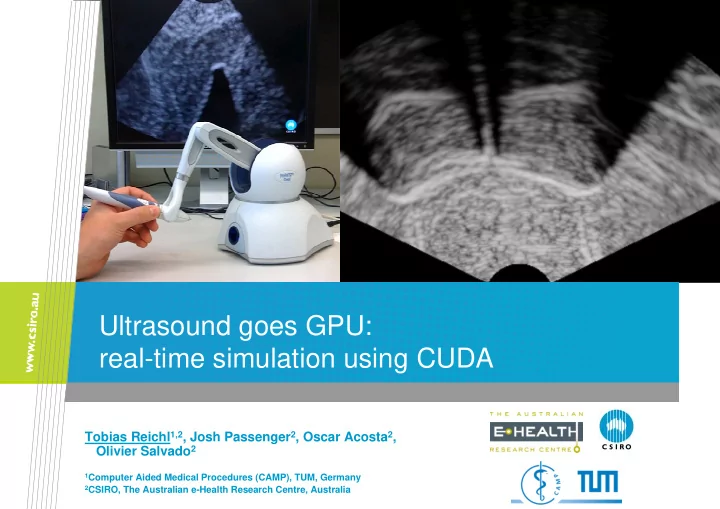

Ultrasound goes GPU: real-time simulation using CUDA Tobias Reichl 1,2 , Josh Passenger 2 , Oscar Acosta 2 , Olivier Salvado 2 1 Computer Aided Medical Procedures (CAMP), TUM, Germany 2 CSIRO, The Australian e-Health Research Centre, Australia
Clinical Problem • Despite increasing use of CT, MRI, etc. medical US remains widely in use because of low cost, non-invasiveness, real-time visual feedback, etc. • Many procedures like US-guided needle insertion require a high degree of hand-eye coordination and extensive training. • For ethical and patient safety reasons training on simulations is preferred. Ultrasound goes GPU: real-time simulation using CUDA - Reichl et al.
Related Work • Jensen 1996: exhaustive simulation of US imaging on the scatterer level • Aiger and Cohen-Or 1998: real-time simulation by slicing 2D US images from 3D volume • Hostettler et al. 2005: ray-tracing US waves, combined with CT textures • Zhu et al. 2006: using synthetic 3D textures based on 2D US samples • Wein et al. 2007: physically derived estimation of US reflection • Shams et al. 2008: combination of US reflection (cf. Wein 2007) with scatter image (cf. Jensen 1996) Common problem: computational effort, e.g. resolution is limited in favor of real-time simulation. Idea: take advantage of modern graphics processors (GPU) and their capabilities for parallel processing Goal: realistic simulation in real-time Ultrasound goes GPU: real-time simulation using CUDA - Reichl et al.
Ultrasound Artifacts • US reflection at tissue boundaries • US attenuation in tissue, shadowing • Speckle noise • Radial blur Ultrasound goes GPU: real-time simulation using CUDA - Reichl et al.
Implementation: Overview Ultrasound goes GPU: real-time simulation using CUDA - Reichl et al.
US Physics: Acoustic Impedance = ρ × • Estimation of acoustic impedance Z c from CT values (Wein et al. 2007) ρ • Using quadratic instead of linear Density of the tissue c interpolation Speed of sound ρ C Z CT Bone [kg/m 3 ] [m/s] [Rayl] [HU] Air 1.2 330 ~400 -1000 Water 1000 1480 1.48 M 0 Water Air Bone 1800 4330 ~7 M 1000 Ultrasound goes GPU: real-time simulation using CUDA - Reichl et al.
US Physics: Snell‘s Law • Specular reflection: 2 cos cos ⋅ θ − ⋅ θ I Z Z = 2 1 r i t cos cos ⋅ θ + ⋅ θ I Z Z 2 1 i i t • Simplification: 2 − I Z Z 0 θ ≈ = 2 1 r i + I Z Z 2 1 i • Combination of specular and diffuse reflection: I cos α ( ) = n r I i • Using n=2: 2 ( ) T ⋅ ∇ I d Z x ( ) = r x 2 ( ) ⋅ I Z x i Ultrasound goes GPU: real-time simulation using CUDA - Reichl et al.
US Physics: Absorption • Approx. 95-100% of attenuation due to absorption • Exponential law, similar to X-ray attenuation: I 10 − α . . / 10 = d f I Bone 0 f US frequency Air α attenuation coefficient Water Ultrasound goes GPU: real-time simulation using CUDA - Reichl et al.
Transmitted Intensity x . . . 3 . 2 . 1 − I I O ( ) ( ) 1 ( , ) = ⋅ Π ⋅ I x I k k d t a 0 t I I 0 ≤ k ≤ x i i Absorption Transmission Ultrasound goes GPU: real-time simulation using CUDA - Reichl et al.
Reflected Intensity 2 − I I ( ) ( ) 1 ( , ) ( ) = Π ⋅ I x I t k a k d R x 0 r I I 0 ≤ ≤ k x i i Transmission Absorption Reflection Ultrasound goes GPU: real-time simulation using CUDA - Reichl et al.
Implementation: Real-time Simulation Demo 1: Image quality Demo 2: Interaction Ultrasound goes GPU: real-time simulation using CUDA - Reichl et al.
Implementation: Simulation Options Ultrasound goes GPU: real-time simulation using CUDA - Reichl et al.
Results: Timing • ~3.3 ms for main computation • Transfer between OpenGL and CUDA might become unnecessary with CUDA 2 • Much time needed for post- processing (blurring, compression) Ultrasound goes GPU: real-time simulation using CUDA - Reichl et al.
Results: Image Quality • Comparison: simulated image (left), real image (right) • Positive feedback from clinicians, collaboration for comparing and validating our results (Robarts Research, Canada) Ultrasound goes GPU: real-time simulation using CUDA - Reichl et al.
Conclusion • New physically plausible approach where computation is possible within the virtual US scan plane, i.e. using only one 2D slice from the original 3D CT volume • No manual annotation or adjustment of the input data necessary • Real-time simulation with „maximum“ resolution (i.e. same as CT data) • Artifacts simulated: shadowing / attenuation, speckle noise, radial and lateral blurring • All virtual acquisition parameters can be interactively changed: US frequency, US intensity, time-gain compensation, field geometry Ultrasound goes GPU: real-time simulation using CUDA - Reichl et al.
Acknowledgements Medical imaging team: Colonoscopy simulator: Olivier Salvado, PhD Josh Passenger Team Leader Project Leader Pierrick Bourgeat, PhD Hans de Visser, PhD Oscar Acosta, PhD David Conlan Jurgen Fripp, PhD David Hellier Jason Dowling Mario Cheng Parnesh Raniga Chris Russ David Raffelt Tobias Reichl Erik Bonner Brendon Evans Ultrasound goes GPU: real-time simulation using CUDA - Reichl et al.
Thank you for your attention! • Questions? Ultrasound goes GPU: real-time simulation using CUDA - Reichl et al.
Recommend
More recommend